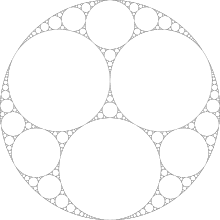Klein group
In mathematics , Kleinian groups play a central role in 3-dimensional topology, hyperbolic geometry and complex analysis.
definition
A Klein group is a discrete subgroup of , the isometric group of 3-dimensional hyperbolic space .
A Klein group is called
Hyperbolic manifold
If is a torsion-free Klein group, then is a hyperbolic manifold . (It is the inner core of the Klein manifold to be associated.)
Limes amount
The Limes set or limit set of a Klein group is a subset of the Riemann sphere , defined as the intersection of the edge at infinity with the end of an orbit with a point of hyperbolic space. The definition of the limit amount is independent of the selected point .
The now proven Ahlfors conjecture says that the Limes set of a finitely generated Klein group is either whole or has Lebesgue measure zero. (The conjecture was proved by Canary in 1993 for topologically tame groups. Together with the tameness conjecture proved by Agol , Calegari and Gabai in 2004 , this implies validity for all finitely generated Klein groups.)
A Klein group is called a Klein group of the first kind if the Limes set is whole . Otherwise it is a Klein group of type 2.
If a Klein group is of the 2nd kind, then the hyperbolic manifold has infinite volume, in particular it is not compact.
The complement of the limit set in is the discontinuity area , it is the maximum subset of , on which actually discontinuous acts. The quotient
is a manifold with a boundary, it is called a Klein manifold .
Area groups
Let it be a discrete, faithful representation of a group of surfaces . Then the Klein group is called a Fuchs group if its Limes set is a circle, quasi- Fuchs group if its Limes set is a Jordan curve and otherwise degenerate Klein group . A degenerate Klein group is called doubly degenerate if its Limes set is the entire 2-sphere and simple degenerates if the complement of the Limes set is connected and not empty.
Geometrically finite Klein groups
A Klein group is called geometrically finite if it fulfills one of the following equivalent conditions:
- there is a fundamental polyhedron with a finite number of faces
- the Dirichlet area has a finite number of faces for everyone
- the convex kernel of has finite volume.
An end of a hyperbolic 3-manifold is called geometrically finite if it has a neighborhood that is disjoint from the convex kernel . Otherwise the end is called geometrically infinite .
A surface group is geometrically finite if and only if it is a quasi-fox group.
Geometrically infinite ends
If one end of a hyperbolic 3-manifold is geometrically infinite, then for every neighborhood of there is a closed geodesic with . For a geometrically infinite end of the form , the end lamination is defined as the lamination of the surface , which is obtained as the limit value of a (each) sequence of geodesics that ultimately leave each compact subset .
The ending lamination theorem proven by Jeffrey Brock , Richard Canary and Yair Minsky states that geometrically infinite ends are uniquely determined by their end lamination.
See also
- Schottky groups are special small groups
literature
- Francis Bonahon : Bouts des variétés hyperboliques de dimension 3rd Ann. of Math. (2) 124 (1986) no. 1, 71-158.

























